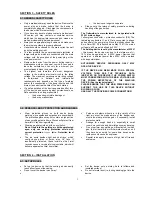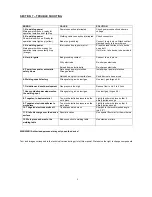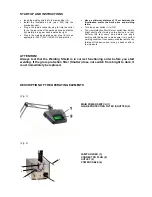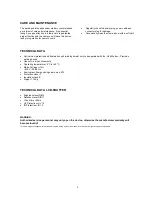
6
5-2. IN GENERAL AND POINTERS
PLEASE NOTE!
Always work with sharpened electrodes!
This is the best way to achieve maximum results.
Make sure the work piece has enough contact to the clamp. If contact problems occur,
make certain the clamp is in contact with a metallic blank location.
Never weld „hands free“, this means; support both hands i.e. on the workbench during
welding. Shaking hands falsify the parameters of the device. .
Apply only minimum pressure onto the electrode tip.
Weld only with minimum gas pressure!
3 to 4 l/min are often sufficient.
TIPS
•
Take enough time to get to know your device.
•
Try out various power levels of the device.
•
Keep in mind that various materials react differently
during welding.
•
Consider the thickness of the material when you
choose the power level.
•
Try to touch the work piece to be welded as precisely
as possible.
•
With just a little experience you will discover how the
angle in which you touch the needle to the work piece
will effect the flow direction of the welding point.
Touching the work piece in an angle of 90
¶
will give
you the deepest welding point.
•
A saw or file can serve well as a „welding addition“.
•
For deeply located welding spots, the electrode
should be longer.
•
It may be helpful to use wire as a welding addition to
close holes or as reinforcement.
•
Only use welding wires as a welding addition, which
are compatible with the used material.
•
If ignition problems occur it is helpful to apply light
pressure to the needle from the side, as if you were
scratching the surface of the work piece.
With this technique you can steer the welding point
into a certain direction.
5-3. SHARPENING THE ELECTRODES
The electrodes should be sharpened with a diamond
grinder with fine or medium grain.
The angle should be ca. 25° (Illus. 4)
5-4. CARE AND MAINTENENCE
The Opti-Welder T1 needs, under ordinary working
conditions, only minimal care and maintenance.
Remembering a couple of points is crucial, though, to
ensure proper functioning and a long life for your welding
device.
•
Regularly check the power plug and power cables, as
well as welding cables for damage.
•
Ensure that the hand piece parts are easy to operate.
•
If necessary, clean the electrode thread of the hand
piece to ensure an optimal contact with the electrode.
WARNING! IF FUSES NEED TO BE REPLACED, REPLACE ONLY WITH THE SAME VALUES. IF DAMAGES OCCUR
AFTER INSTALLING INAPPROPRIATE FUSES (I.E. TOO STRONG) THE WARRANTY BECOMES INVALID.
AUTHORIZED PERSONNEL MAY ONLY OPEN THE DEVICE!
Summary of Contents for optiwelder T1
Page 11: ...10...

































